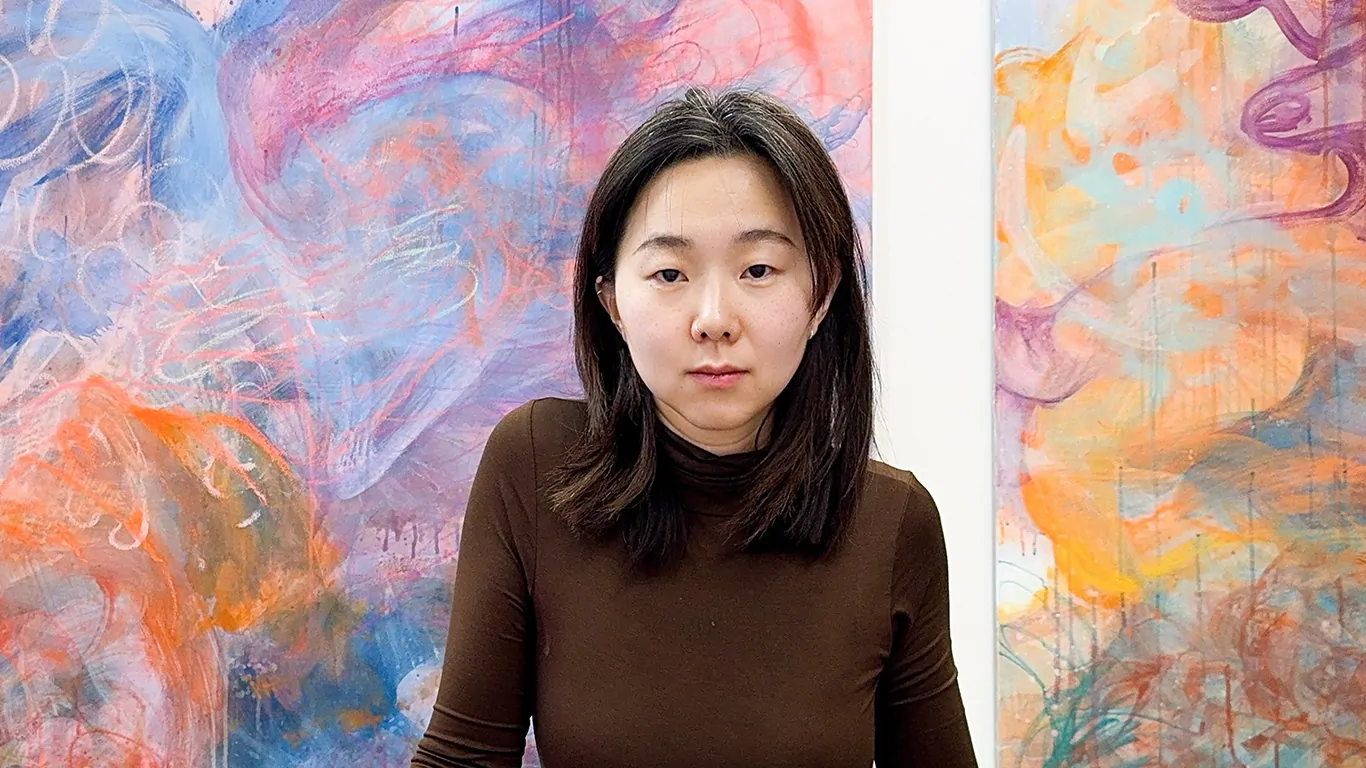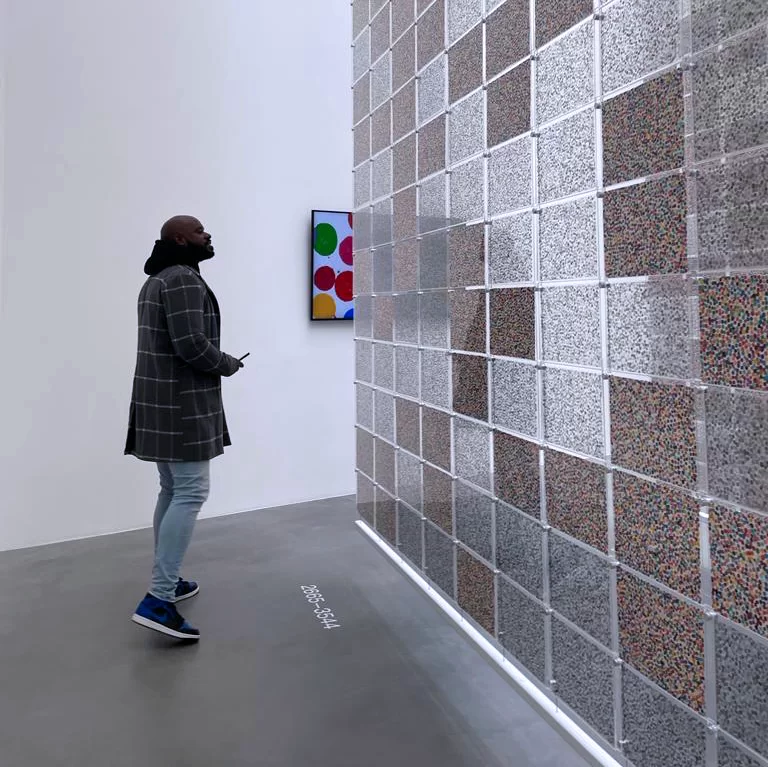Freya Fang Wang’s intuitive abstractions, rooted in Taoist philosophy and informed by her cross-cultural background, convey a quiet intensity that favours process over polish and sincerity over spectacle.
Freya Fang Wang’s paintings ripple and pulse as if caught mid-breath—each canvas a living record of movement, resonance, and quiet reflection. Rooted in Taoist philosophy yet distinctly contemporary in execution, her work explores stillness, spontaneity, and the invisible forces that shape our internal and external worlds.
Wang draws from her lived experience, becoming a dialogue with the murmurs of the cosmos, the rhythms of nature, and the layered spaces where Eastern and Western perspectives converge. Her process, which she describes as both personal and cosmic, follows the Taoist principle of Wu Wei—a way of making without force or resistance. She steps into the studio without a fixed plan, allowing each work to take shape through interaction with materials and intuition. Her compositions—layering rice paper, acrylic, ink, plaster and oil pastel—form a visual language that bridges the material and the ephemeral.
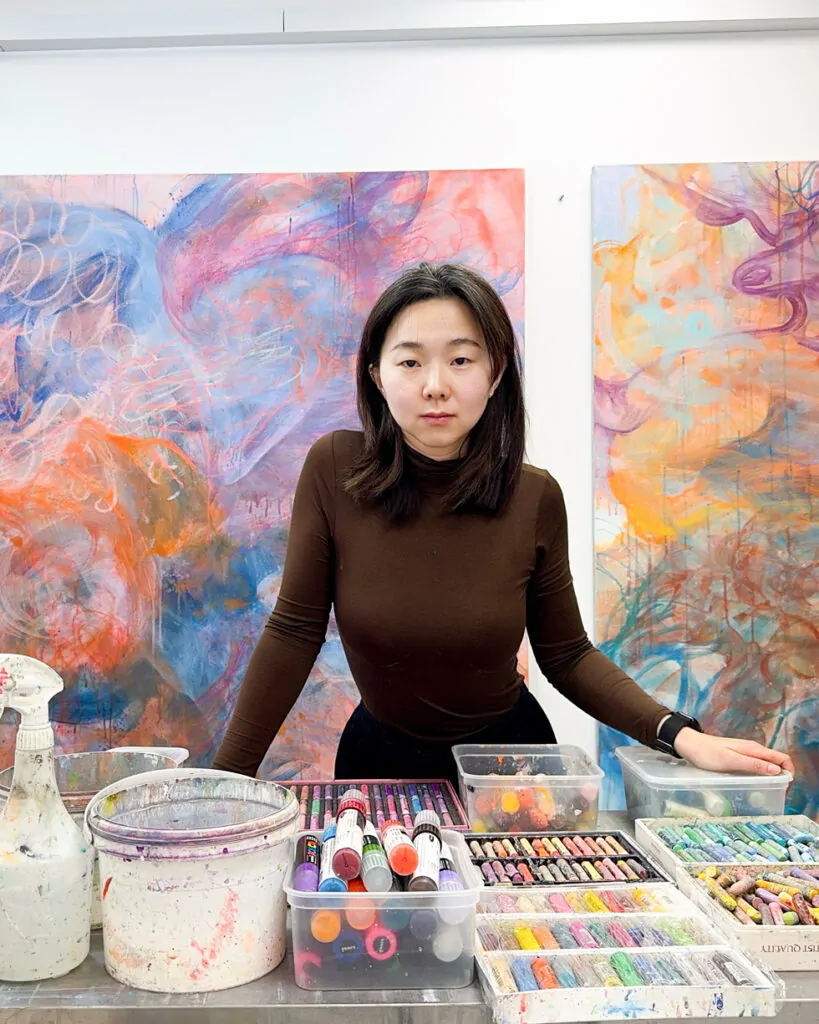
I often feel a deep sense of sadness and concern about the state of our world today. we’re living in an increasingly fragmented reality—not just within human society
Freya Fang Wang
In works such as Odyssey, a large diptych, Wang invites the viewer into a shifting field of colour and gesture. Smouldering oranges and dusky violets crackle across the surface, while soft cerulean and ghostly whites drift like vapour across a pale ground. Drips, splatters, and spontaneous strokes accumulate into a textured terrain that evokes subconscious movement—part internal landscape, part elemental force. Though there are echoes of abstract expressionism, Wang’s work avoids its theatrics. Her mark-making feels unguarded, grounded in presence rather than performance.
This is not abstraction for abstraction’s sake. These works function as meditations on change, vulnerability, and the cyclical nature of existence. There is a willingness to let the process remain visible—to allow the drips and ruptures to speak. Viewers are not asked to interpret, but to enter—to engage with the work physically, emotionally, and intuitively. At a time when much of contemporary art is shaped by irony or conceptual detachment, Wang’s practice stands out for its quiet sincerity. It is measured, open, and emotionally direct.
Born in Beijing and now based in London, Wang moves fluidly between cultural and artistic traditions. Rather than positioning her work within one framework, she draws from a broad field of influences to reflect something more universal. Through patient layering and instinctive mark-making, she creates works that feel like portals—inviting us into a space where perception softens and awareness expands.
Wang studied at the Central Academy of Fine Arts in Beijing and the Royal College of Art in London. Her work has been exhibited internationally, from Taiwan to the United Kingdom. In conversation, she speaks about the evolving nature of her practice, the influence of Taoist thought, and the role of intuitive expression in tracing emotional and energetic states.
You describe your paintings as ‘mirrors that connect all the creatures in the natural world.’ In what ways do you see your work functioning as both a reflection and a connector in our increasingly fragmented world?
Freya Fang Wang: I often feel a deep sense of sadness and concern about the state of our world today. As you mentioned, we’re living in an increasingly fragmented reality—not just within human society, but particularly in our relationship with the natural world and other living beings.
Through my work, I hope to inspire reflection from a perspective rooted in a profound sense of interconnectedness within the broader system of nature—beyond just the human world. I see humans as just one form of existence among many, all interconnected and coexisting within the natural environment. My hope is that my work can encourage a more harmonious and coexistent relationship with nature, with the universe, and within ourselves.
Taoism appears to be a central influence in your practice—particularly the idea of flow and interconnectedness. How do you translate such an abstract, spiritual principle into tangible, visual forms?
Freya Fang Wang: Taoism believes in a cosmic force flowing through and binding every existence together as a whole. I think it’s more like my personal experience. For example, when I was hiking in nature, like in the forest, I could always feel the energy flow around me, and also flow through my body from the earth to heaven. And also, when I see those huge trees, I am always surprised by the power of nature and growth.
I always believe that some very powerful invisible energy deep in nature is supporting and running the world visible as we see and live in. So I try to visualise this deep inner power through my practice all along the years. And when I came to London and started my course at RCA, I think I finally found some strong connection to it in Taoism, and the pathway toward it has become clearer step by step over the years.
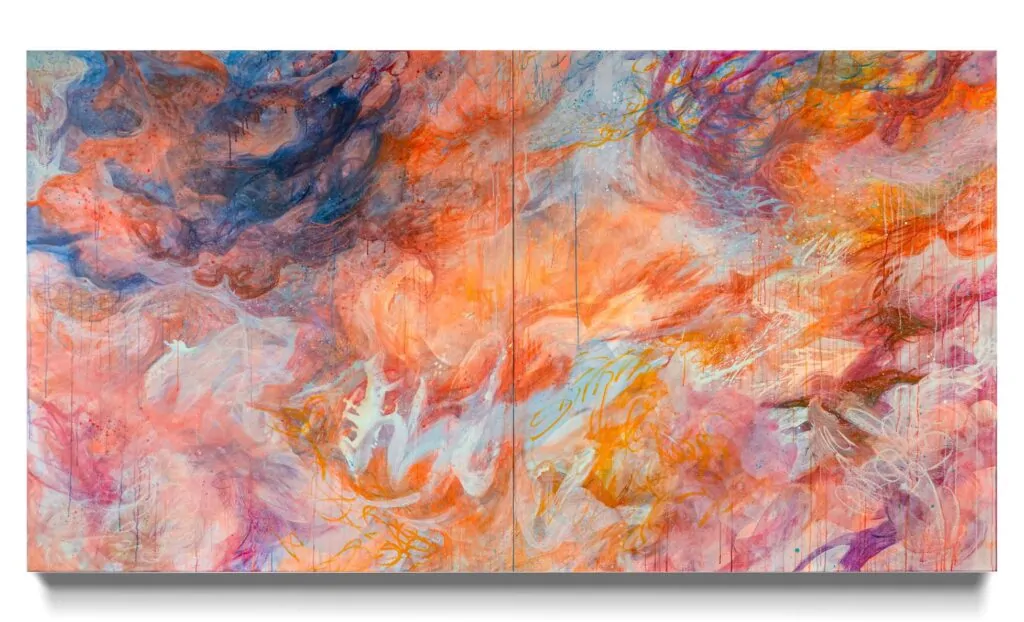
160x300cm Diptych (HxW)
Acrylic, Acrylic Marker, Oil Pastel, Oil Stick on Canvas, 2025
© Freya Fang Wang
Your work engages with contemporary concerns around climate and spirituality. How do you see these two areas converging in your paintings? Are they in conflict, in harmony—or perhaps seeking a new balance?
Freya Fang Wang: I don’t think they’re in conflict for me, and my painting and concept are embracing all of them. And no matter how messy the human world is, nature could always keep its balance in its own way. And the balance embraces everything as equal and connected together. I hope my work could inspire some thought on it.
I think in my painting, they form balance on their own in the process, and are released into the broader balance in nature. So the balance is always there, no need to seek it.
Your process is described as both meditative and embodied. Could you talk us through a typical day in the studio? Do you follow a ritualistic approach or embrace spontaneity?
Freya Fang Wang: My art exploration and personal self-exploration are one; they inspire each other and have been developing together. At this point, I’d better mention my current approach and method of doing my painting. The painting is mainly based on intuition, and each of them is a totally new journey that I’m sharing with the painting. During the process, I gradually step back, bit by bit, and let the painting lead. The only thing I’m very sure of is that the painting and I will go together—no need to worry about where to go or how to go. Just fully believe in the painting with all my concentration!
Each time I return to continue a piece, I begin by standing in front of the canvas hanging on the wall. I close my eyes and take a moment to calm myself. When I feel ready, I open my eyes and try to perceive the field with a fresh sense of presence. In doing so, I feel I can engage with the system again—reconnecting with it and preparing myself to continue the work.
And every time, the painting brings me some surprise of myself, and I can see a bit of a new me in each piece—a bit of something I didn’t know before. So I find myself really enjoying and looking forward to sharing a new journey with the paintings. In this way, the subconsciousness and intuition can flow out naturally, and the whole energy field becomes activated.
While creating this particular piece, I quite literally felt myself dissolve into the field and vibration, merging with a greater existence—whatever name one might give it. The sense of connection was incredibly real—solid, powerful—I could feel it with every cell in my body.
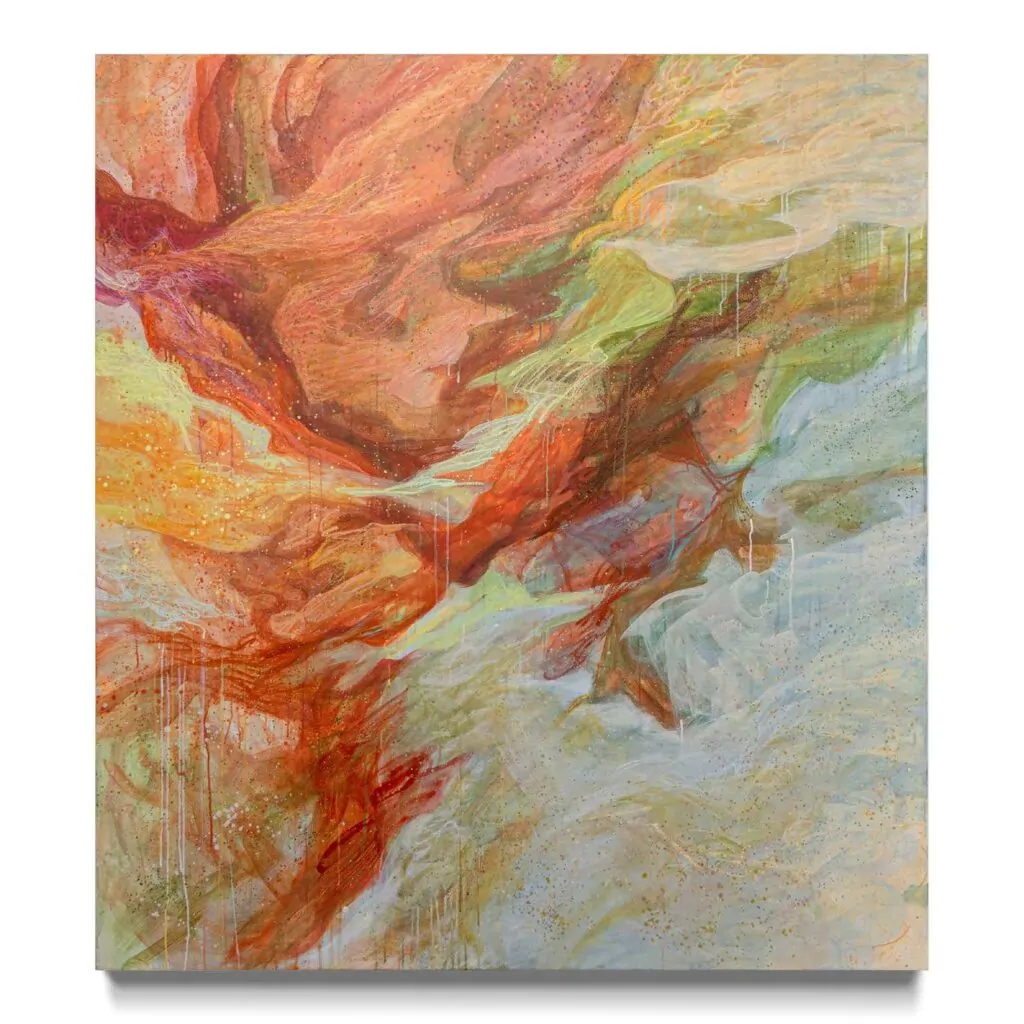
167.64 x1 52.4cm (HxW)
Acrylic, Acrylic Marker, Oil Pastel, Oil
Stick on Canvas
2024
You employ a deeply layered technique—using rice paper, acrylic, ink, plaster, glass paper, and oil pastels. What draws you to these particular materials, and how do they reflect your themes of connection and transformation?
Freya Fang Wang: I think these materials helped me a lot to form and evolve my concept in the beginning, in the past. Textural and material elements were—and still are—one of my interests. In the first year at RCA, I did a lot of experimental work, using glass paper and rice paper a lot. I see them as the container and holder of the material, and the material is energy itself, such as soil and water. I see the texture they created as the history and trace of the energy’s existence over time.
In the process, I kept rethinking the way I see the concept of energy, and how I understood it, over and over again. Then, in the second year, I gained a clearer idea that the most important point I wanted to explore is the interconnection and the unified wholeness of this deep energy—not just its existence. So I developed my material focus on acrylic, oil pastel, and oil stick, so that I could build more layers, deeper and deeper into the canvas space, as much as I could.
And I couldn’t be where I am now without any of the previous steps. They’ve all been very important in the evolution of my practice.
How does the act of layering relate to memory, time, or consciousness in your work? Are you constructing worlds—or peeling them away?
Freya Fang Wang: I really like this question! I would describe it as constructing an energy field, where the process of layering allows the space in the canvas to deepen—reaching towards the vastness of the universe. Along with the physical layering on the canvas, each layer also seems to draw my inner world of consciousness further inward, into that same deeper universe. In this way, two dimensions—one external, one internal—travel along different pathways, yet ultimately converge as one within the infinite cosmos.
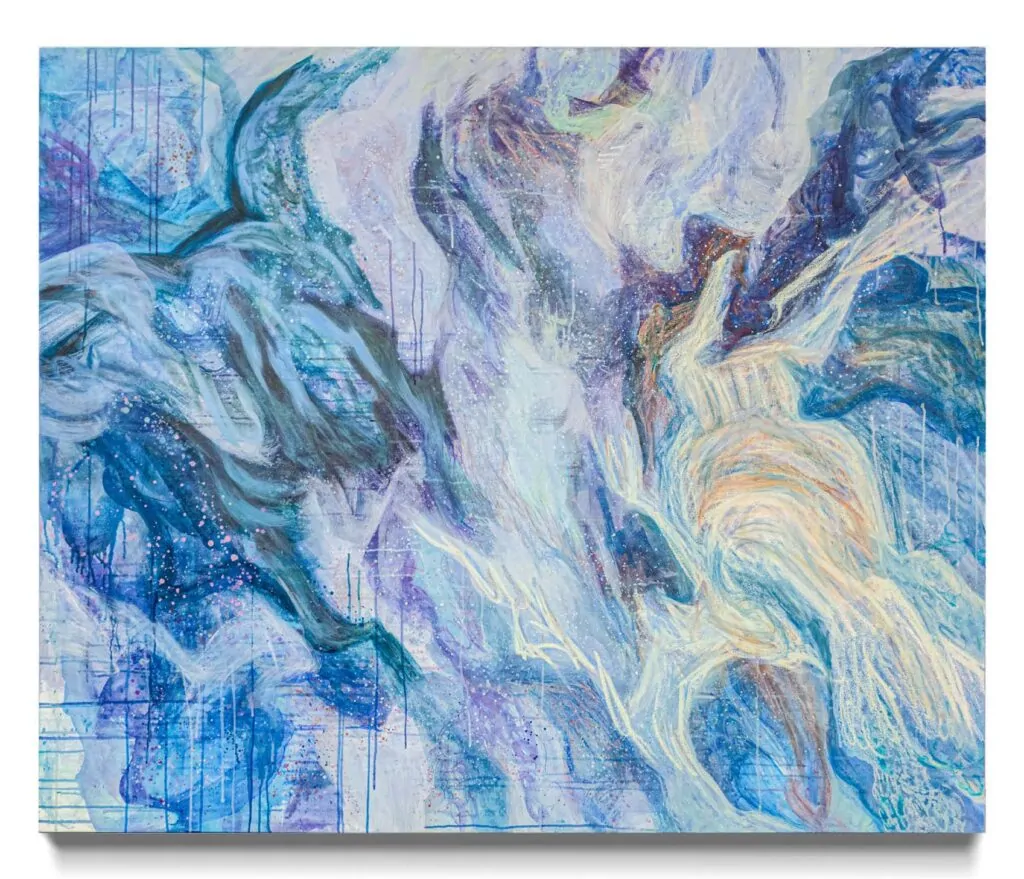
145x175cm (HxW)
Acrylic, Acrylic Marker, Oil Pastel, Oil Stick on Canvas 2024
You’ve expressed a desire to speak to the universal human experience beyond distinctions between Eastern and Western cultures. How do you navigate your identity as an artist raised in Beijing and now based in London?
Freya Fang Wang: In my self-exploration, I’ve always been drawn to examining the relationship between myself and the world I live in. Through this process, I hope to discover clues about who I am and how I might exist within this world. One of my deepest longings is to rediscover a connection to nature — something I’ve often felt is missing.
When it comes to the idea of belonging, I’ve never truly felt a sense of safety or grounding in any particular culture or country. To me, these are human-made constructs, and I struggle to see them as reliable foundations for identity. In fact, cultural differences often seem to create disconnection and misunderstanding, which makes me doubt whether a lasting solution can be found within cultural frameworks alone.
As a result, I find myself needing to reflect more deeply — to seek a path that goes beyond cultural boundaries, in a broader and more universal dimension.
There’s always been a question lingering in my mind: why do I feel such an urgent need to reconnect? The answer revealed itself through my diptych Odyssey. I came to understand that this urgency comes from a longing for a stable and trustworthy sense of belonging — not to any particular culture or system, but to something far greater. In that piece, I experienced a profound, tangible connection to a larger existence — the universe itself. It gave me a deep sense of safety, stability, and trust — something that felt so real and solid.
Perhaps that’s the dimension I’ve been seeking — one where I am rooted in Chinese culture, yet constantly reaching beyond it to reflect myself in a wider world.
Do you believe there’s a universal visual language that exists beyond cultural context? If so, how do you discover or articulate it through your practice?
Freya Fang Wang: Yes, absolutely. I believe my painting is one such example. The visual language of painting can indeed communicate beyond spoken words—especially when the work is rooted in a deep, shared sense of humanity. When art touches on something universal, it can bypass cultural and linguistic barriers entirely.
This insight has been affirmed many times through the feedback I’ve received from viewers. One especially meaningful moment occurred during my graduation exhibition. A local woman stood silently in front of one of my paintings for a long time. Even before I had the chance to explain anything, she had already felt the atmosphere and essence I intended to convey—without needing any words. That moment has stayed with me ever since.
Interestingly, in Norse mythology, it is believed that everything in nature has a spirit. This idea resonates strongly with the core values of Taoism, which emphasises reverence for natural energy and the harmony of all living beings. Although these beliefs come from entirely different cultural traditions, they align in a deeply meaningful way. That realisation has been a powerful source of inspiration for me.
It made me understand that when an artwork begins from a place of shared human sensitivity, it can transcend language, culture—even time and space—and speak directly to the human heart. Perhaps that’s the power of art, and of humanity itself. Painting, in particular, becomes a visual medium through which such connection can happen—and that is exactly what I hope to achieve through my work.
Your brushwork is often described as ‘swirling’ and ‘vibrational.’ Are you attempting to capture a frequency or resonance beyond the visible? What role does sound, movement, or even silence play in your process?
Freya Fang Wang: I always try to visualise the vibration that exists beyond the visible world. In my mind, I perceive it as an infinite, constantly moving web — an interwoven network stretching out into eternity. It supports and holds the world from deep within. I often imagine it as a field of intertwining waves and particles, with my body becoming a small channel through which this flow can pass.
I believe that the movement of the body is a crucial element in my work, as it activates the vibration and flow within the field during the painting process, and extends my subconsciousness into deeper meditative states and dimensions.
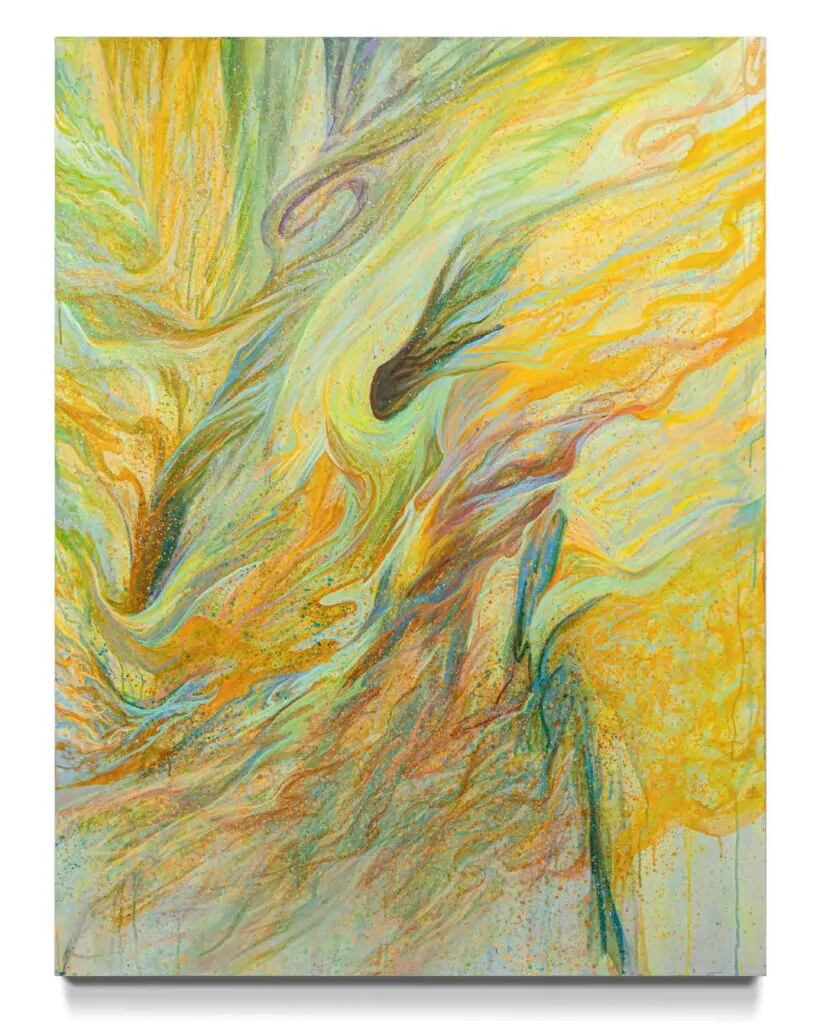
165x125cm (HxW)
Acrylic, Oil Pastel, Oil Stick, Plaster,
Pencil on Canvas
2024
The cosmos is a recurring theme in your work. Are your paintings intended to map something celestial—or to serve as portals into something more intangible?
Freya Fang Wang: For me, instead of being a map, they’re more like infinite networks, webs, and waves that extend endlessly—continuously growing and intertwining with one another within the field and the universe.
I also firmly believe they can serve as gateways to unknown worlds — mysterious, invisible, yet undeniably real. I have always believed in their existence, much like a hidden, intangible world. Just like this piece — the diptych Odyssey.
What do you hope people carry with them after encountering your work? Is it a feeling, a question, a memory—or something even more ineffable?
Freya Fang Wang: Actually, it’s a very open space. I see it more as the creation of a vibrational field — one that gently invites people in, encourages them to linger, and perhaps leaves behind a feeling or trace of something meaningful, whatever that may be.
The power of this field is that, after spending some time within it, you naturally begin to tap into its vibration and resonance. Hopefully, this leads to a sense of interconnection and wholeness. I believe this experience is deeply nourishing — something that is often missing in our modern lives.
There’s no need to overanalyse what exactly this feeling is, what causes it, or how it happens. The only thing that truly matters is that you’ve experienced it.
©2025 Freya Fang Wang


